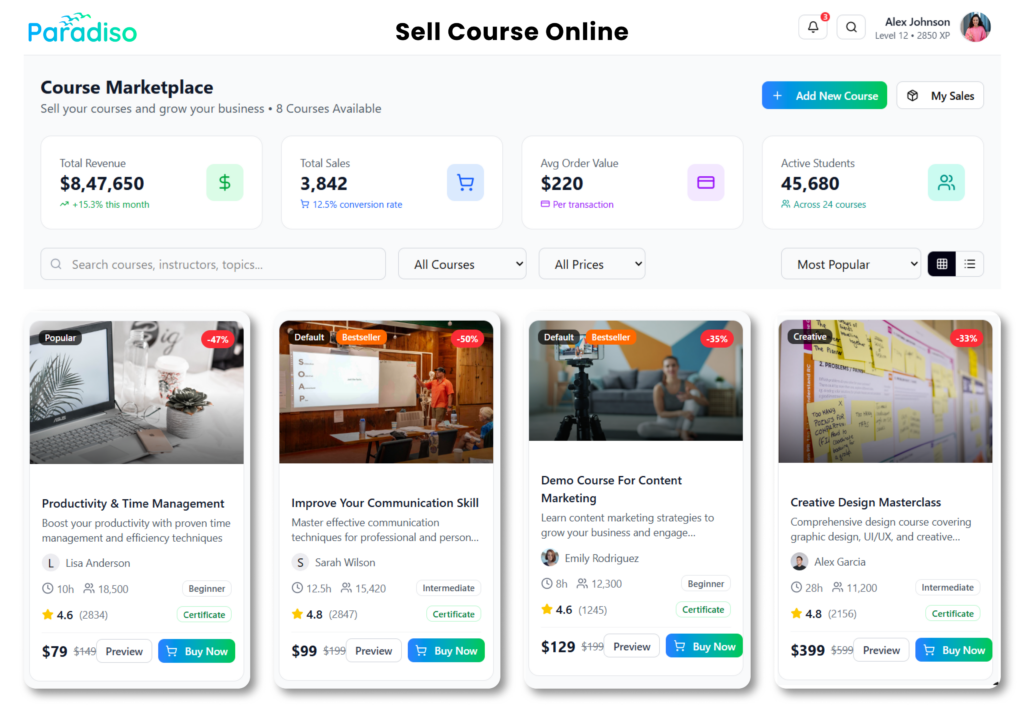Online education has become a popular alternative to traditional brick-and-mortar classrooms due to advancements in technology and the increasing demand for flexible learning options. This shift has also led to the development of new teaching methods that are specifically designed for the online learning environment.
These modern teaching methods aim to enhance student engagement, improve learning outcomes, and make the education process more accessible and convenient. From gamification and project-based learning to AI and VR technology, these innovative teaching methods are revolutionizing the way students learn online and helping to close the education gap for students who might otherwise miss out on the benefits of traditional education.
Modern Teaching Methods All Educators Should Know
1. Flipped Classroom
Let’s begin with the most widely used modern teaching strategy. Students are instructed in traditional teaching methods to learn the material first in the classroom and then to study on their own at home. Students in a flipped classroom first learn about the topic on their own, then return to the classroom to answer questions and practice with a project or other activity that fits the subject’s scope. Students benefit from this approach by becoming more involved in their education and gaining more autonomy. Students become their own teachers rather than relying on their teacher to introduce them to the material and perform all of the heavy lifting.2. Tactile learning
It also known as kinesthetic learning, involves hands-on activities and demonstrations. The teacher demonstrates activity and students practice simultaneously from home using this teaching method in online classrooms as well. It is best suited for practical subjects and skills in which students need to build things or develop their dexterity.3. VAK Learning
In comparison to the previously mentioned tactile method, VAK learning encompasses all three types of learners: kinesthetic, auditory, and visual senses Visual learners (tutorials, presentations, infographics, diagrams, and charts), auditory learners (podcasts, videos, and discussions), and kinesthetic learners (acting out the material) absorb information more effectively. Using a variety of learning materials, you can be sure that your students will always anticipate the next step in VAK learning, which has something for everyone.4. Project-Based Learning
Students are required to work on a practical or theoretical project in project-based learning. The teacher assigns the project. Not abstract problems, but rather real-world ones, are the goals of projects. Projects can be assigned individually or in small groups. Regardless, the best example of active learning is working on a project. It encourages students to think practically and fosters creativity and problem-solving skills.5. Problem-Based Learning
Project-based learning is similar to problem-based learning, but the problem is presented first in problem-based learning. The best way for students to finish the project can be decided individually or in groups. The difficulty level of problem-based learning gradually rises as we progress from basic knowledge and initial discovery to more complex projects.6. Collaborative Learning
The term “collaborative learning” encompasses any project or activity in which students collaborate with one another. Building valuable soft skills like teamwork, delegation, time management, collaboration, decision-making, and social skills is made easier with a lesson plan that is based on collaborative learning. Students also begin to develop their self-awareness through collaborative activities, where they must evaluate their strengths and select a project role based on their skills.7. Cooperative Learning
This learning method is similar to collaborative learning. The teacher organizes students into small groups, assigning each member a specific role and task to carry out. In cooperative learning, students have a common goal to reach – alongside, they learn to collaborate, take responsibility, and develop team spirit.8. Game-Based Learning
Essentially, game-based learning refers to the practice of incorporating games into instruction. Games are particularly engaging because they serve as their own kind of “distraction” from standard education and contain elements of active learning. The syllabus can include online, group, or role-playing games. Learning becomes an adventure when games automatically add variety to the environment.9. Inquiry-Based Learning
In today’s education, inquiry-based learning is a popular learning strategy. When a teacher asks an open-ended question or gives a project to students, they usually conduct their own research to finish the project or come up with a theory. These activities can be completed by students on their own or in small groups. The instructor has the option of either guiding the students through the appropriate investigation method or letting them figure it out on their own.10. Thinking-Based Learning
Because it is a “complementary” type of learning, thinking-based learning can and should be used in conjunction with all instructional approaches. Thinking-based activities involve asking more in-depth questions and “challenging” a particular fact’s truth. After completing a project, thinking-based learning can also take the form of self-reflection. The instructor encourages students to identify their methodology’s strengths and weaknesses as well as what they could have done differently. Critical thinking, analytical thinking abilities, and self-awareness are all enhanced by this teaching strategy.11. Competency-Based Learning
Competency-based learning can be used with other approaches as well. Teachers in competency-based education use student assessments and hands-on projects to determine whether or not a student is ready to advance to a higher level of difficulty.12. Independent Learning
Students in independent learning have complete control over their education, from choosing what and how they will learn to evaluate themselves. The teacher’s role shifts to that of a facilitator, but they can still participate in this process. By providing the student with learning materials and feedback on their progress, they can support the student.Learning Has Changed – Are You In?
Today, we’ve explored some exciting teaching strategies that have gained momentum and changed how students learn. Modern learning experiences are rich, substantial, and interactive, with students developing valuable life skills that will accompany them all their lives.
If you want to create these experiences in an online learning environment, look no further than Paradiso LMS. Try our platform with a free trial and see all the amazing content you can create and build your own online school. .













